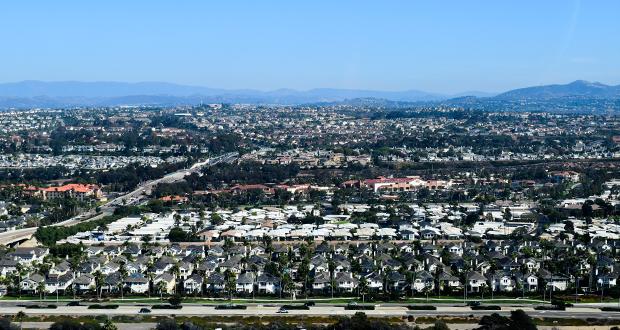North County mayors: Big-city solutions can’t be shoehorned into smaller cities
Leaders of Carlsbad, Vista and San Marcos discuss topics at San Diego industry group-sponsored presentation
February 25, 2023
What works well in the governance of big metros such as San Diego is not necessarily a good fit for smaller cities. That was the message delivered by the mayors of Carlsbad, San Marcos, Vista and Coronado during a recent presentation sponsored by the Building Industry Association of San Diego.
Key among the issues addressed by the elected leaders were housing and traffic, which are front-and-center topics in communities across the county.
More specifically, they noted the current effort led by the city of San Diego to address traffic and housing supply issues by creating mass transit corridors with high-density housing, similar to what’s done in European and East Coast cities.

San Marcos Mayor Rebecca Jones led off the discussion, saying, “We’re fighting so many things; we have mandates, redevelopment funds are gone, we don’t have the means to pay for things.”
What can be done and how her colleagues plan to take on the issue of affordable housing and all that goes with it were among the questions she posed.
“We’re at 24% below the county’s median income,” Vista Mayor John Franklin responded. “I’m focused as mayor on making sure that we grow our per capita tax base. I want to make sure that we build quality housing that adds to the per capita tax base, not reducing it.”
He called on the developers’ trade organization to help him find ways for people to have quality affordable housing.
“So we’re looking forward to working with you to figure out how we do that,” he said.

For Carlsbad, Mayor Keith Blackburn said his biggest obstacle is getting buy-in from his City Council members on affordability issues.
“This is a very contentious issue,” Blackburn said, and his biggest concern is the wide disparity in perspectives among council members. He’s held elected office for 14 years, and the incoming council is younger.
“There’s a huge generation gap, and if we can have a cohesive, well-working council,” he said, then the city can accomplish what needs to be done, he suggested.
In Coronado, the reality is the city is never going to have “workforce housing,” Mayor Richard Bailey said.
“Housing along the coast is always going to be significantly more expensive than the median household prices throughout the rest of the county,” he said.
As an example, the city’s affordable housing effort involved the purchase of a two-bedroom, two-bath unit for $1.75 million. The city only purchased it because the funds it received required it to buy affordable housing. Bailey said he felt it wasn’t an effective use of taxpayer funds.
The real problem cities are seeing up and down the state is that “these very lofty goals that are completely out of touch with basic economic, and geographic realities for the County of San Diego,” he said.
As an example, Bailey cited what he said are the billions of dollars that are being proposed to build out the mass transit system in hopes of reducing the use of cars on roads and freeways.
“I think residents throughout our region are waking up to that,” he said. “And so one of my goals is to do a better job informing the electorate on how these public policies are directly affecting your quality of life.”
Transportation, the elected leaders agreed, is at the heart of most issues.
“It’s the elephant in the room,” said Jones of San Marcos. “I think all of us at some point in time have balanced transportation with all the needs we face in our cities.”
“Cars and transportation have an effect on upwards mobility and the jobs that people can have,” she said. There is a strong “correlation between transportation and housing.”
Driving such concerns is a multi-billion-dollar transportation plan approved a couple of years ago by the San Diego Association of Governments to vastly expand rail and transit.

Franklin from Vista said he believes “the big elephant in the room is talking about developing to the east of (Interstate) 15. We should be building new communities.”
He continued: “The idea that you’re going to push people on the bus or a train, who live in a suburban community, and drive great distances, just doesn’t make sense.
“What about the people that, you know, they’re the lowest in the income spectrum? They want to own a vehicle so that they have the economic liberty to get home and be with their families. I know that people who don’t have the money to afford a car wish that they could afford a car so that they can have the same independence and liberty that we have in this room. And that’s a fundamental freedom that I am absolutely committed to fight for.”
Carlsbad’s Blackburn said that mass transit doesn’t work for his city and will not work for the region as a whole.
“Today, transit moves fewer than 2% of all commuters,” Blackburn said. The question is, “Why is our transit system so inefficient? There is not the density of a Manhattan to support current thinking of transit as fixed lines on buses or trolleys running on a fixed schedule for one specific destination.
“The entire transportation model is moving away from that. We’re moving towards clean autonomous vehicles, they’re going to take it from door to door.”
Nobody is going to be able to live in a city like Carlsbad, spread out over 40 square miles, and depend on transit to replace the cars, Blackburn said.
J.W. August is a longtime San Diego broadcast and digital journalist.
Letters to the editor are welcome. Send letters to www.northcoastcurrent.com/letters/.




